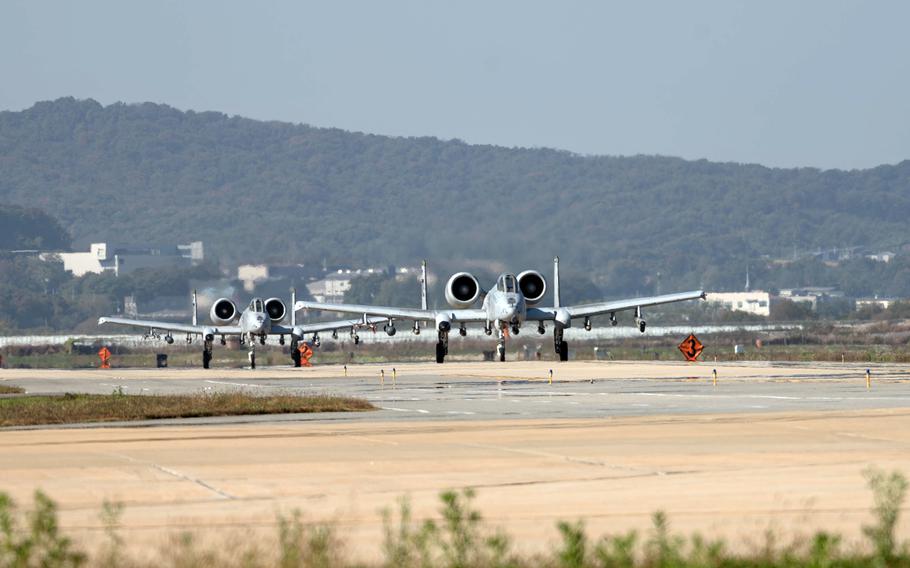
A-10C Thunderbolt IIs from the 25th Fighter Squadron take the runway ahead of Vigilant Defense at Osan Air Base, South Korea, Oct. 29, 2023. (Aubree Owens/U.S. Air Force)
CAMP HUMPHREYS, South Korea — Over 130 U.S., South Korean and Australian aircraft began large-scale airpower drills this week to improve their teamwork, three days after U.S. and South Korean soldiers concluded a ground and air exercise.
Vigilant Defense, a five-day exercise that kicked off Monday, is taking place throughout South Korea with 25 types of aircraft, including U.S. F-35B Lightning IIs and F/A-18 Hornets, and South Korean F-35As and E-737 airborne early warning and control aircraft, according to a Ministry of National Defense news release Saturday.
A KC-30A multirole tanker transport from the Royal Australian Air Force will conduct aerial refueling drills, the release said. The Australian air force first appeared for the exercise last year when a KC-30A refueled South Korean KF-16s and U.S. F-35Bs.
Vigilant Defense follows a three-day ground and air exercise by South Korea’s Ground Operations Command. The unnamed training by over 5,000 troops demonstrated the allies’ response to surprise attacks and long-range artillery fire on South Korea, the command said in a news release Friday.
Vigilant Defense features various scenarios, including squadron flights, emergency air blockades and close air support, according to the National Defense Ministry.
The three air forces are training “to immediately respond to any provocation of an enemy,” South Korean air force Col. Kang Geun-shin said in the release.
The 7th Air Force in a news release Friday described the airpower exercise as a “regularly scheduled event” that is “not related to any current real-world threats or situations.”
“Combat readiness is perishable, and the training value of Vigilant Defense is one of the highlights of the year, as we put our skills together and learn to operate as a combined and joint team as the culmination of many months of planning,” the release said.
Around 100 U.S. and 140 South Korean aircraft flew roughly 1,600 sorties during last year’s large-scale aerial exercise, dubbed Vigilant Storm. The annual exercise was previously called Combined Flying Training Event and Vigilant Ace.
As Vigilant Storm was underway, North Korea launched 23 short-range ballistic and surface-to-air missiles on Nov. 2, 2022. The communist regime fired six more ballistic missiles the following day, including an intercontinental ballistic missile that flew about 466 miles before landing in the Sea of Japan, or the East Sea.
North Korean ruling party secretary Pak Jong Chon demanded Washington and Seoul stop Vigilant Storm and described the exercise as “a big mistake,” according to a state-run Korean Central News Agency report on Nov. 3.
North Korea has fired 21 ballistic missiles — four of them intercontinental range — in 14 days of testing so far this year.